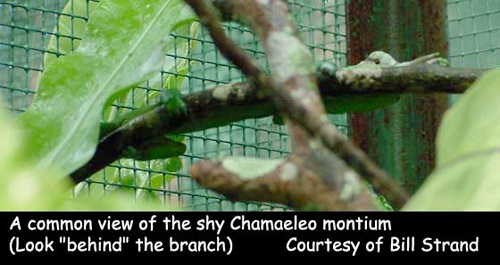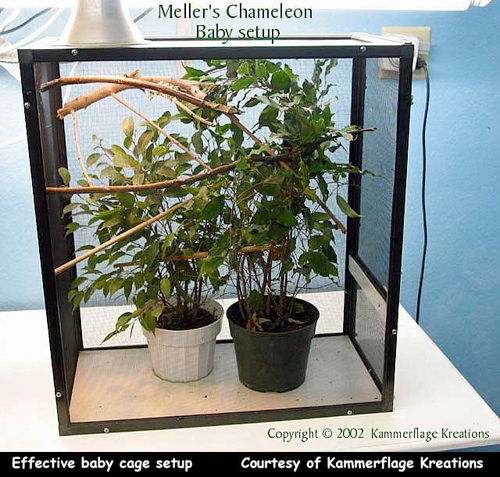



Gradients: Give Your Chameleons a Choice
By Bill Strand
Citation:
Strand, B. (2002). Gradients: Give Your Chameleons a Choice. Chameleons! Online E-Zine, November 2002. (http://www.chameleonnews.com/02NovStrand.html)
Gradients: Give Your Chameleons a Choice
Introduction:
The first question asked by most chameleon keepers when setting up for their first chameleon is how big the cage must be. The basic answer is to get the chameleon as big of a cage as is possible! There is solid truth to that answer, but the reason why is just as important. A general axiom is that the smaller the cage the more responsibility you as the keeper take on to provide the correct environment. Conversely, the larger the cage, the more freedom that is given to the chameleon to choose it's micro climate the less responsibility you as the keeper take on. Simply put - the larger the cage the easier it gets. You must create a number of micro climates to satisfy your chameleon's daily needs and the larger the cage the more micro climates can be created.
Micro climates are not a subject new to us. We have the same needs. We can compare a small cage with a car and a large cage with a house. It is easier for us to find a comfortable place in a house than in a car. In a house some rooms or floors are warmer or brighter. In the morning we can sit by the window to warm up in the rising sun, while during the hot afternoon we retreat to inner, cooler rooms of the house. A car on the other hand, has one climate at any one time. In California I can leave the house in the morning with the heater on and have to put on the air conditioning before arriving at work. While in my house I can adjust my position for comfort the small airspace of the car requires me to constantly juggle the heater, air conditioning, and windows up/down/partially down. Not only does the environment in the car swing dramatically, but my environmental comfort level changes depending on how long I have been awake, what temperature drink I have just finished, and how stressed I get during the drive. The point of this analogy is that if you give your chameleon enough room to choose his environment you will not have to be there all day putting on the heater, air conditioner, and rolling the windows up or down. Give a chameleon the right size cage in which you have created gradients and you can free yourself up to go to work, spend time with your family, and engage in other of life's trivialities.
What is a Gradient?
A gradient is a set of values that changes from low to high (or the other way around). An example is a rainbow. A rainbow starts at the color red (which is the lowest frequency in the visible spectrum) and slowly progresses through the visible spectrum until purple. Although distinct colors can be seen in the rainbow it is difficult to determine just where the red ends and the orange begins! Closer to the subject at hand is a spot light for you chameleon's cage. By putting a spotlight on one end of a cage you provide your chameleon with an area to bask in the morning to warm up. Whether the chameleon cage is tall or long or both the further the chameleon gets from the spot light the cooler he will be. That is a gradient - hot at the top and a gradual drop to cool at the bottom. The three gradients to keep in mind when designing a cage are temperature, humidity, and privacy.
Temperature - Research your chameleon species to determine what the ideal daytime high and low temperature is. Your task is to create that high in one corner of the cage and the low in the opposite corner of the cage. To create the high end place a spot light to shine on the "hot corner" of the cage. The distance the spot light needs to be to create the required highest temperature can be determined by placing a thermometer at the closest spot the chameleon can get to the spot light and moving the spot light away until the temperature is right. By following these instructions you will quickly determine that the lamp needs to be outside the cage. If there is any possibility that the chameleon can touch the bulb itself the chameleon WILL touch the bulb and serious burns may result. The task once your high point is set is to get the change of temperature from the high point to the low point as gradual as possible.
When setting up a screen cage in your house the ambient temperature of your house will be your minimum value on your temperature gradient. If your house temperature hovers around the mid-70s F (a standard chameleon comfort level) then your job is made easy. A screen cage large enough that the chameleon can get to an area unaffected by the spot light will take care of your temperature gradient.
If your house temperature is low (60s F or lower) you run into the problem that the temperature drops dramatically when the chameleon leaves the direct area of the spot light. This translates out to the chameleon being either too or too cold. Have you ever been camping where at night it is too hot near the fire, but too cold away from the fire? Sooner or later you just give up and crawl into your sleeping bag! For the chameleon cage the way to smooth out this hot/cold transition is to make some or all the walls solid to hold in the heat and raise the minimum point on your temperature gradient. Walls may be partially solid (ie. top half only) or full solid form top to bottom as your particular case dictates. But beware of the combination of solid walls and a heat source. You solidify walls to keep in the heat remember they will not stop keeping in the heat when your required minimum temperature is met. The heat source must be balanced with ventilation to produce an acceptable environment or else your cage will turn into an oven and the chameleon will experience health issues or death. Once you set up your environment you must supervise it to make sure the correct balance is achieved. Balance methods include putting spot lights on timers so they only come on during the cold mornings or putting non-visible heat sources (ceramic heaters, etc..) on thermostats to guard against overheating.
If your ambient house temperature is in the upper ranges for the species of your choice an air conditioner or swamp cooler may be the answer. It is important, though that a cool draft not be blowing directly on the chameleon.
Humidity - Controlling humidity has many of the same aspects as controlling temperature. If the ambient room humidity is too low placing a humidity source in the cage and making some walls solid will help. The best source of humidity is a living plant. The plant itself and the moist dirt will provide localized humidity. External humidifiers, waterfalls, and air bubblers can also be utilized. Special care must be exercised whenever humidity devices are used as dampness is a good breeding group for bacteria. Humidifiers must be cleaned regularly. Waterfalls or air bubblers must be placed so that food items cannot crawl in or the chameleon cannot defecate into the water. It is so easy for a waterfall or air bubbler to turn into a bacterial soup that having these items inside a cage is more trouble than it is worth. If they are to be used for humidity purposes have them separated from the chameleon and its food by a vertical screen barrier. Since humidity is a complicated thing to control in the small environment of the cage it is frequently easier to humidify the whole room.
A humidity gradient may be created by keeping the room humidity at a comfortable minimum and creating a dense leafy perching area for the chameleon. I create what I call a "chameleon retreat". It performs the function mostly to meet the privacy needs of a chameleon (discussed soon), but it also functions to provide an area of increased humidity. The retreat consists of a perching branch that is surrounded by leaves. The object is to make an living cave. This closed area will gather the moisture produced by the leaves and create a micro climate with increased humidity. Creating this area over moist dirt will increase the humidity of the retreat. Be vigilant to remove any feces or dead food items from the cage - especially the ones that fall on the dark/moist dirt of the retreat - as the bacterial and parasitical mess they create are health hazards.
Privacy - A privacy gradient is a difficult one to create in a home cage, but critical to a chameleon's long term survival. Chameleons in my care have shown various levels of tolerance to being noticed. One method of giving a chameleon it's privacy is to have its cage away from high traffic areas of the house. Another approach is to create varying levels of exposure in the cage. By giving them areas of full exposure, dappled exposure, and minimal exposure I allow the chameleon to interact with me on it's own terms. I like to give even my most gregarious chameleons their retreats. I have male panther chameleons that come clamoring out of the trees when they see me coming as they know food is to be had. As soon as they are full and have no more use for me they have the choice to lumber back into their retreat area or just ignore me and warm their belly in the sun. The important thing is that they have a choice. This becomes more critical when dealing with a nervous individual. My C. montium only come out when no one is around. As soon as a human shows up they freeze and hope the big animal goes away or they slowly melt into their privacy area. For the montium the privacy area is critical to it's feeling of security. An animal unable to feel secure will live in a state of stress. An animal in a constant state of stress will live a shortened life. The montium may stress more dramatically than the pardalis and die sooner, but even the above "tame" panther chameleon will experience a certain amount of stress if constantly on display.

For a outgoing animal such as a panther chameleon a ficus tree with leaf cover may be enough. For a shy species such as a C. montium or C. cristatus, more cover will be appreciated. A method I have used to create a "thick" retreat for the shy species in an indoor cage is to place a horizontal perching stick in a corner of the cage. About 9 inches (depending on the size of the chameleon) above the stick I hang a lush pothos, spider plant, or other leafy trailing vine. I then arrange branches and the vines so that the chameleon can sit comfortably on the branch without touching any of the leaves, branches, or pot. The most important thing is that chameleon thinks it is difficult for you to see inside the area, but it is possible for the chameleon to monitor outside happenings through cracks in the "leaf wall". To further increase your chameleon's feeling of security never make direct eye contact with your chameleon while it is in it's retreat. By glancing by them but not giving away that you have picked them out you can check on them, but still confirm in their minds that their camouflage has worked.
Conclusion:
So, back to our question. How big should a chameleon cage be? The real answer is as big as it takes to provide a chameleon with the temperature, humidity, and privacy gradients it requires! This is hardly a simple topic, but the purpose of this article is to explain why a beginner is told to get the largest cage possible. It is not necessarily to give the chameleon room to wander, but more to allow you as the keeper space in which to create the various micro environments necessary for your chameleon's well being.

The cage setup pictured above was designed for a baby Chamaeleo melleri. This cage setup would work for any baby chameleon. A setup like this may be made on a larger scale to handle an adult chameleon. How long this cage would work for a chameleon while it grows is dependent on how fast the baby grows and how big it will get as an adult.
Temperature - the heat lamp on the left corner of the cage shines on sticks that are arranged at various distances. This allows the chameleon to vary his basking temperature. Sticks on the right hand side of the cage allow the chameleon to avoid the light all together. The spot light is on a timer which can be set for a couple hours in the morning if just a warm up is required or left on for the whole day and to be automatically switched off when the day is done.
Humidity - Copious leaves from two potted plants help with the environment. Since this is a screen cage the ambient humidity level is maintained by either natural weather or by a room humidifier.
Privacy - Baby chameleons will have no problem feeling secure in trees of this density.

Bill Strand

Bill Strand currently works in the area of exotic animal breeding and continues to refine husbandry techniques with a broad range of chameleon species. A special interest of his is the creation of captive environments. He was the Assistant Editor and Webmaster of this Chameleons! E-Zine from March 2002-March 2004.









Join Our Facebook Page for Updates on New Issues:
© 2002-2014 Chameleonnews.com All rights reserved.
Reproduction in whole or part expressly forbidden without permission from the publisher. For permission, please contact the editor at editor@chameleonnews.com
